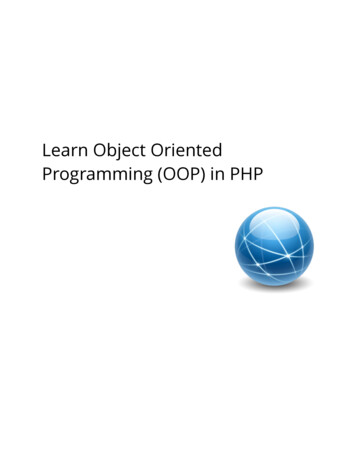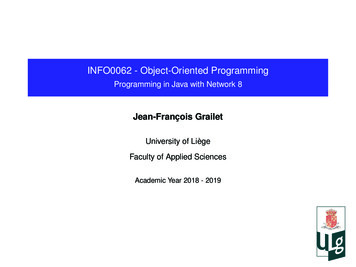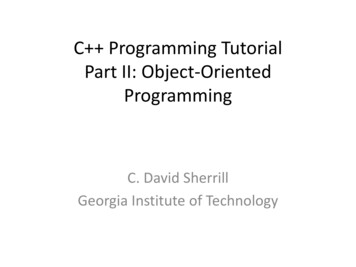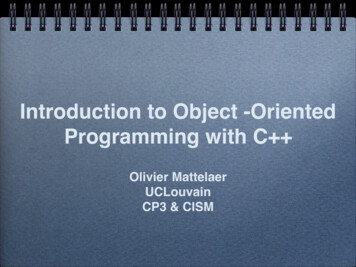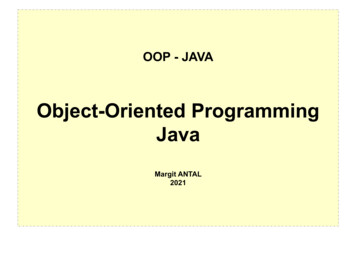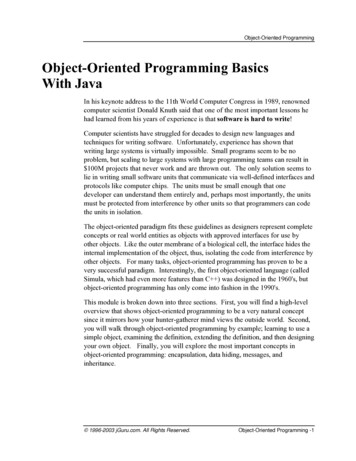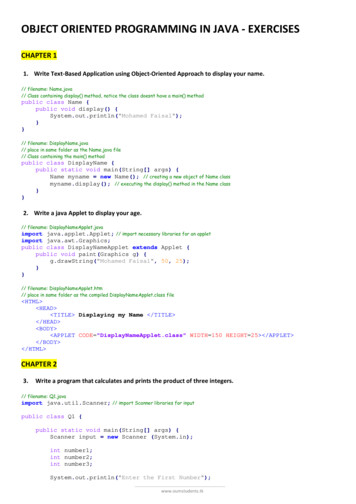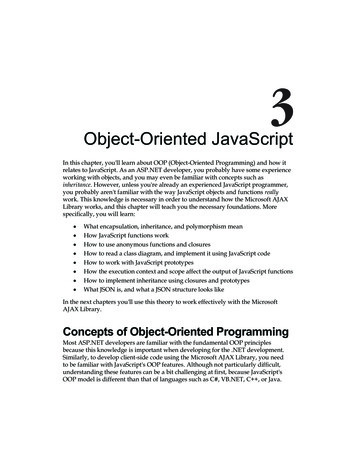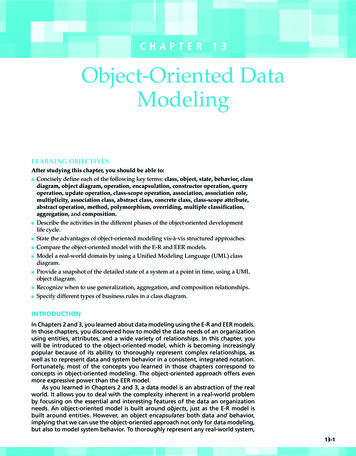
Transcription
STATE CONTROLLED OBJECT ORIENTED PROGRAMMING(Thesis format: Monograph)byJamil AhmedGraduate Program in Computer ScienceA thesis submitted in partial fulfillmentof the requirements for the degree ofDoctor of PhilosophyThe School of Graduate and Postdoctoral StudiesThe University of Western OntarioLondon, Ontario, CanadaApril, 2014 Jamil Ahmed 2014
AbstractIn this thesis, we examine an extension to the idea of object oriented programming to makeprograms easier for people and compilers to understand. Often objects behave differentlydepending on the history of past operations as well as their input that is their behaviordepends on state. We may think of the fields of an object as encoding two kinds ofinformation: data that makes up the useful information in the object and state that controls itsbehavior. Object oriented languages do not distinguish these two. We propose that byspecifying these two, programs become clearer for people to write and understand and easierfor machines to transform and optimize.We introduce the notion of state controlled object oriented programming, abbreviatedas “SCOOP”, which encompasses explicit support of state in objects. While introducing anextension to object oriented programming, our objective is to minimize any burden on theprogrammer while programming with SCOOP. Static detection of the current state of anobject by programming languages has been a challenge. To overcome this challenge withoutcompromising our objective, a technique is presented that advances contemporary work.We propose an implementation scheme for a SCOOP compiler that effectivelysynchronizes the external and internal representation of state of objects. As an implication ofthis scheme, SCOOP would provide the memento design pattern by default.We also show how a portion of an object particular to its state can be replaceddynamically, allowing state dependent polymorphism. Further, we discuss how programscoded in SCOOP can be model checked.Keyword: State Oriented Programming, Object Oriented Programming, Typestate, FiniteState Automata, Dynamic Compositional Adaptation, Specification and Verification.ii
AcknowledgmentsI would like to express my heartily gratitude for being supervised by Prof. Dr. Stephen. M.Watt. Without his guidance, mentorship, vision and shrewd insight, this work would have notbeen accomplished. I am highly impressed how his extraordinary determination, humbleness,patience and intellect overcome difficult situations not only in computing research but also innormal day to day life. His immense support, consistently motivating attitude and willingnessto elucidate significantly contributed to this research. I have highly benefited by his skill ofnot just preparing his students for thesis defense but also preparing them to researchindependently.I will always be deeply thankful to my original supervisor Prof. Dr. Sheng Yu. Although hisprecious advice lasted temporally for only two year due to his sudden passing in Jan 2012, itwill enlighten my career forever. His initial work related to this thesis sparked tremendousideas to integrate in this research. It was a difficult time when he passed, half way into myPhD program, and then Dr. Stephen M. Watt kindly accepted supervising me and gave mefreedom of thought.I am thankful for the funding for my PhD program from Higher Education CommissionPakistan, University of Karachi and Western Graduate Research Scholarship of Departmentof Computer Science, Western University.I am also thankful to my brother Sherjil Ahmed for many fruitful technical discussions. Theselfless love and care from my parents gave me the confidence to go through the entirehorizons of my PhD program and life as well.iii
ContentsAbstract . iiAcknowledgments. iiiTypographic Conventions . viiiAbbreviations . ixList of Figures . xChapter 1.11Introduction .11.1State Controlled Object Oriented Programming .11.2State Abstraction .31.3Motivation.41.4Contribution of Thesis.61.5Thesis Orientation .8Chapter 2.102Main Concepts .102.1Definitions .102.2Typestate .112.3Software Verification .132.4The Object Protocol .132.5Typestate Based Polymorphism.142.6The Typestate Invariant .142.7Typestate Extension .142.8Typestate Mapping .152.9State Preservation.152.10Dynamic Adaptation .162.11Feasible for Model Checking .16Chapter 3.173Case Studies of SCOOP .173.1Screen Redraw Thread .173.2Electronic Workbench (EWB) Stated Process .20iv
3.3Electronic Workbench Stated Process With a Stated Screen Redraw Thread.223.4Lexical Analyzer .243.5A Simple Two Tank Pumping System .273.6CIP System .283.7Digital Counter Composed of Flip-Flops .303.8Master Detail Data Entry and Navigation Form .303.9Elevator .323.10Bank Account System .333.11Queue.343.12Iterator .363.13Printer .383.14File .39Chapter 4.414Background and Related Work .414.1Typestate .414.2Typestate Extension and Subclassing .434.3Typestate Tracking .434.4Aliasing .444.5Typestate Invariant .454.6Dynamic Behavior Adaptation .46Chapter 5.475A Static Typestate Checking Technique under Aliasing .475.1Introduction .475.2Presentation .475.3The SCOOP Language .485.4Stated Type System.525.5Default Typestates .535.6A Programmer’s View .545.7A Language Implementer’s View .555.8State Classes.565.9Characteristics of State Classes.575.10The Proxy and State Class Architecture .58v
5.11Creating Stated Objects .615.12Functional Interface of a Stated Object .615.13Typestate Coercion .625.14The Alias Table .635.15Tracking Aliases .645.16Static Typestate Tracking .655.17Typestate Checking .665.17.1Static Typestate Checking .665.17.2Dynamic Typestate Checking .695.18Conclusion .71Chapter 6.726The Typestate Invariant .726.1Introduction .726.2Motivation.
3.4 ‘CIP System’ Stated Object Model 30 3.5 ‘Elevator’ Stated Object Model 33 3.6 ‘File’ Stated Object Model 40 5.1 A SCOOP Program 54 5.2 SCOOP language-generated File Stated Object 56 5.3 Proxy and State Architecture of File Stated Object 59 5.4 A Sketch of Proxy and State Class Architecture for File Stated Object in openfile Typestate With Alias Table, Symbol Table and Invariant .

